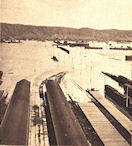Search the Blog
Categories
- Books & Reading
- Broadband Buzz
- Census
- Education & Training
- General
- Grants
- Information Resources
- Library Management
- Nebraska Center for the Book
- Nebraska Libraries on the Web
- Nebraska Memories
- Now hiring @ your library
- Preservation
- Pretty Sweet Tech
- Programming
- Public Library Boards of Trustees
- Public Relations
- Talking Book & Braille Service (TBBS)
- Technology
- Uncategorized
- What's Up Doc / Govdocs
- Youth Services
Archives
Subscribe
Category Archives: Nebraska Memories
Nebraska Memories Challenge
Earlier this week I had the pleasure of traveling to the Nebraska panhandle. After returning from my trip I took a few minutes to explore the items included in Nebraska Memories from the panhandle region. This was easy to do using the Browse by Location map. Looking at the map you can see that the state is divided into six regions. Clicking on a region will display all of the items in Nebraska Memories that have been identified as being from that specific region of the state.
 I’d like to issue a challenge to everyone reading this blog post. Using the Browse by Location map select a region of Nebraska and view all of the items from that region. As you are viewing the items make note of an item or two that catches your attention. When you are done return to this blog post and leave a comment sharing what region you selected and the title of the item or items that stood out to you.
I’d like to issue a challenge to everyone reading this blog post. Using the Browse by Location map select a region of Nebraska and view all of the items from that region. As you are viewing the items make note of an item or two that catches your attention. When you are done return to this blog post and leave a comment sharing what region you selected and the title of the item or items that stood out to you.
I’ll get things started. I selected the panhandle region. Here are three different photos that caught my attention.
- Welcome sign, Crawford, NE – I liked this photo simply because it made me smile when I read it.
- Millinery Department of the Sidney Mercantile Company – The hats are beautiful and I’m sure the ladies who made them were proud to have their photo taken with them. Looking at the photo however all I can think is how happy I am that those hats are no longer in style because I’d hate to have to wear them.

- McNair Hardware – Look at the great rockers in this photo. I wonder if any of those rockers are still being used today.
If you’re up for the challenge use the Browse by Location map to browse the Nebraska Memories collection and then leave a comment sharing the title(s) of the item(s) that caught your attention. I should warn you I found it hard to limit myself to only three items!
Visit Nebraska Memories to search for or browse through many more historical images digitized from photographs, negatives, postcards, maps, lantern slides, books and other materials.
Nebraska Memories is a cooperative project to digitize Nebraska-related historical and cultural heritage materials and make them available to researchers of all ages via the Internet. Nebraska Memories is brought to you by the Nebraska Library Commission. If your institution is interested in participating in Nebraska Memories, see http://nlc.nebraska.gov/nebraskamemories/participation.aspx for more information, or contact Beth Goble, Government Information Services Director, or Devra Dragos, Technology & Access Services Director.
Posted in General, Information Resources, Nebraska Memories, Technology
4 Comments
Dog Days
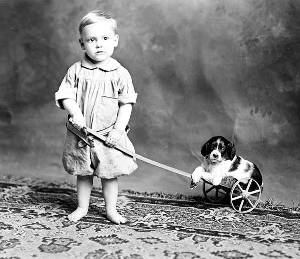 We Nebraskans are used to suffering through blisteringly hot days in late summer, and we sometimes refer to them as the Dog Days. The phrase comes from the Roman calendar, which referred to the period spanning July 24 to August 24 as diēs caniculārēs, associated with the star Sirius. Sirius is called the Dog Star, and is the brightest star in the constellation Canis Major.
We Nebraskans are used to suffering through blisteringly hot days in late summer, and we sometimes refer to them as the Dog Days. The phrase comes from the Roman calendar, which referred to the period spanning July 24 to August 24 as diēs caniculārēs, associated with the star Sirius. Sirius is called the Dog Star, and is the brightest star in the constellation Canis Major.
Another definition from Wikipedia seems ironic considering the anything-but-slow performance of the stock market this summer: In recent years, the phrase “Dog Days” or “Dog Days of Summer” have also found new meanings. The term has frequently been used in reference to the American stock market. Typically, summer is a very slow time for the stock market, and additionally, poorly performing stocks with little future potential are frequently known as “dogs”.
While we may not always associate hot weather with constellations, finance or dogs, the waning days of summer do seem like a good time to celebrate our canine companions. A search in Nebraska Memories brings up a wealth of images of dogs in their various roles. The pampered household pet in the image above must have been the darling of it’s family. 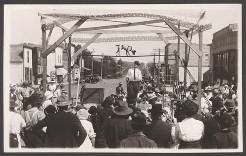
Others were working dogs pulling travois for their native masters or herding cattle for their rancher owners. Still others were entertainers like the dog walking on the tight rope depicted here. I hope it wasn’t too scared doing the high wire act! Or they may simply have been overheated pooches getting into the shade like this one in front of Blondy’s Barber Shop and Pool Hall in Brainard.
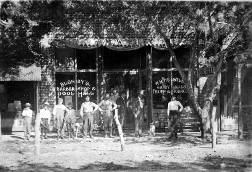 Visit Nebraska Memories to search for or browse through many more historical images digitized from photographs, negatives, postcards, maps, lantern slides, books and other materials.
Visit Nebraska Memories to search for or browse through many more historical images digitized from photographs, negatives, postcards, maps, lantern slides, books and other materials.
Nebraska Memories is a cooperative project to digitize Nebraska-related historical and cultural heritage materials and make them available to researchers of all ages via the Internet. Nebraska Memories is brought to you by the Nebraska Library Commission. If your institution is interested in participating in Nebraska Memories, see
<http://nlc.nebraska.gov/nebraskamemories> for more information, or contact Beth Goble, Government Information Services Director, or Devra Dragos ,Technology & Access Services Director.
Parks and Recreation
Now that the weather has cooled off a little bit, perhaps you are thinking of getting outside and visiting a local park. If it’s still too hot for you, you can enjoy the images of parks in Nebraska Memories instead. While parks have been an important part of many Nebraska towns, the Nebraska Memories collection is especially rich in images of Omaha’s parks.
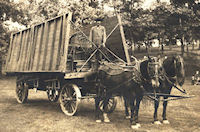 The parks of Omaha have been used for many recreational purposes, including performances. At Hanscom Park, a portable bandstand could be brought in with horses when needed for performance events. Other parks had more permanent structures, such as this pavilion in Riverview Park.
The parks of Omaha have been used for many recreational purposes, including performances. At Hanscom Park, a portable bandstand could be brought in with horses when needed for performance events. Other parks had more permanent structures, such as this pavilion in Riverview Park.

Parks also provide more informal recreational opportunities for children and adults alike. These boys are enjoying a merry-go-round in a local park, and Peony Park provides the backdrop for a game of horseshoes for this group of men.
 In addition to recreation, parks often serve as nature retreats in the middle of an urban landscape. The long winding drive in Miller Park and the lagoon in Fontenelle Park are just a couple examples of the beauty of nature in the middle of Omaha.
In addition to recreation, parks often serve as nature retreats in the middle of an urban landscape. The long winding drive in Miller Park and the lagoon in Fontenelle Park are just a couple examples of the beauty of nature in the middle of Omaha.
Visit Nebraska Memories to search for or browse through many more historical images digitized from photographs, negatives, postcards, maps, lantern slides, books and other materials.
Nebraska Memories is a cooperative project to digitize Nebraska-related historical and cultural heritage materials and make them available to researchers of all ages via the Internet. Nebraska Memories is brought to you by the Nebraska Library Commission. If your institution is interested in participating in Nebraska Memories, see http://nlc.nebraska.gov/nebraskamemories/participation.aspx for more information, or contact Beth Goble, Government Information Services Director, or Devra Dragos, Technology & Access Services Director.
On the Road Again
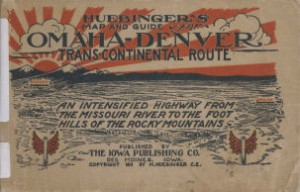 Planning a road trip this summer? Taking along a GPS device? Check out this old-fashioned positioning system— Huebinger’s Map and Guide for Omaha-Denver Trans-continental Route : with Supplement Showing Overland Trail Connecting Omaha-Denver Trans-continental Route at Lincoln with the Waubonsie Trail at Nebraska City (1911) from the Hastings Public Library Collection in Nebraska Memories.
Planning a road trip this summer? Taking along a GPS device? Check out this old-fashioned positioning system— Huebinger’s Map and Guide for Omaha-Denver Trans-continental Route : with Supplement Showing Overland Trail Connecting Omaha-Denver Trans-continental Route at Lincoln with the Waubonsie Trail at Nebraska City (1911) from the Hastings Public Library Collection in Nebraska Memories.
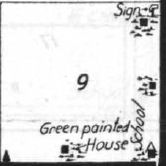 If you are driving east and coming up on Harvard, Nebraska, (page 136) be on the lookout for the green-painted house on the left and then a school where you would turn north. Then, after you pass a pond on the left and a batten-board barn on the right, be ready for a right-turn to head east again. Of course, it helps if you have a navigator along to read off the landmarks.
If you are driving east and coming up on Harvard, Nebraska, (page 136) be on the lookout for the green-painted house on the left and then a school where you would turn north. Then, after you pass a pond on the left and a batten-board barn on the right, be ready for a right-turn to head east again. Of course, it helps if you have a navigator along to read off the landmarks.
Once you’ve made it to Harvard (480.4 miles from Denver and only another 151.9 to Omaha) , do you need a hotel for the night? Try Hotel Harvard—only two dollars on the American plan. Or perhaps you need a garage to top off the gas tank? Two choice are listed. Would you like more information about Harvard and its residents? Check out page 22.
Another book of maps in this collection, Official Road Book of the Nebraska State Automobile Association (1913), includes a digest of states’ auto laws, telling motorists that in Nebraska, they must register with the Secretary of State in Lincoln for a fee of $2 per year and supply their own tags. And keep a light foot on the gas pedal because the speed limits are “10 miles an hour in business section; 15 miles in residence district; 20 miles elsewhere.”
Now, as you pull out of Harvard and head on down the road toward Omaha, keep an eye out for the danger sign ahead by the red barn …
Visit Nebraska Memories to search for or browse through many more historical images digitized from maps, photographs, negatives, postcards, lantern slides, books and other materials.
Nebraska Memories is a cooperative project to digitize Nebraska-related historical and cultural heritage materials and make them available to researchers of all ages via the Internet. Nebraska Memories is brought to you by the Nebraska Library Commission. If your institution is interested in participating in Nebraska Memories, see http://nlc.nebraska.gov/nebraskamemories/participation.aspx for more information, or contact Beth Goble, Government Information Services Director, or Devra Dragos, Technology & Access Services Director.
Thoughts of Snow
As the temperature and heat index are reaching the 100+ degree mark for many of us this week I thought it would be the perfect time to think about snow, lots of cold snow. Depending on your viewpoint the thought of snow may make you appreciate the recent hot temperatures or it could give you something cold to dream about.
If you are a snow lover like myself let’s think about how cool life will be in four or five months and the snow is flying. Hopefully the weather will be perfect like it was in the early 1900’s for a little girl and her dog to go skiing and for the Boston sisters to enjoy a sled ride. If you’re a bit adventures you may even enjoy some football like the 1909 Nebraska State Normal School at Kearney football team. Anyone interested in a snowball fight?
 For those of you who do not share my love for snow take a look at these photos of the 1927 and 1949 blizzards that hit Crawford or the large snow fall at Fort Niobrara in the late 1880’s. Think about how cold it must have been when these photos were taken. Does looking at these photos and thinking about past snow falls make the hot temperatures of this week a bit more bearable? Enjoy the heat while you can because before you know it you too may be shoveling snow.
For those of you who do not share my love for snow take a look at these photos of the 1927 and 1949 blizzards that hit Crawford or the large snow fall at Fort Niobrara in the late 1880’s. Think about how cold it must have been when these photos were taken. Does looking at these photos and thinking about past snow falls make the hot temperatures of this week a bit more bearable? Enjoy the heat while you can because before you know it you too may be shoveling snow.
Visit Nebraska Memories to search for or browse through many more historical images digitized from photographs, negatives, postcards, maps, lantern slides, books and other materials.
Nebraska Memories is a cooperative project to digitize Nebraska-related historical and cultural heritage materials and make them available to researchers of all ages via the Internet. Nebraska Memories is brought to you by the Nebraska Library Commission. If your institution is interested in participating in Nebraska Memories, see http://nlc.nebraska.gov/nebraskamemories/participation.aspx for more information, or contact Beth Goble, Government Information Services Director, or Devra Dragos, Technology & Access Services Director.
Things Are Going Swimmingly
Are you tired of the hot July weather? Take a moment to explore these refreshing images of swimmers in Nebraska Memories.
 These women are enjoying the water at Linoma Beach, which was founded in 1924 as a “pleasure resort” halfway between Lincoln and
These women are enjoying the water at Linoma Beach, which was founded in 1924 as a “pleasure resort” halfway between Lincoln and 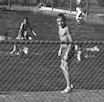 Omaha.
Omaha.
This boy is among the swimmers relaxing at the David City Municipal Pool in a 1948 photograph.
This  swimming hole at an unknown Nebraska location shows another way in which people have taken to the water for recreation.
swimming hole at an unknown Nebraska location shows another way in which people have taken to the water for recreation.
Visit Nebraska Memories to search for or browse through many more historical images digitized from photographs, negatives, postcards, maps, lantern slides, books and other materials.
Nebraska Memories is a cooperative project to digitize Nebraska-related historical and cultural heritage materials and make them available to researchers of all ages via the Internet. Nebraska Memories is brought to you by the Nebraska Library Commission. If your institution is interested in participating in Nebraska Memories, see http://nlc.nebraska.gov/nebraskamemories/participation.aspx for more information, or contact Beth Goble, Government Information Services Director, or Devra Dragos, Technology & Access Services Director.
Down on the Farm
It’s summer, farmers are working hard, and crops and animals are growing. If you are interested in seeing farm life from a century or so ago, check out Nebras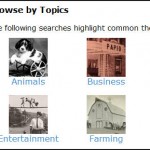 ka Memories, a database containing historical images digitized from photographs, negatives, postcards, maps, lantern slides, books and other materials.
ka Memories, a database containing historical images digitized from photographs, negatives, postcards, maps, lantern slides, books and other materials.
Browse and Search provide different ways to find images in Nebraska Memories. On the Browse page, under “Browse by Topics” is a link to a sample of “Farming” images. If you want to see more images like the one you are looking at, click one of the subject headings from the item description.
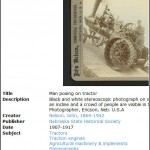 For example, you could click “Tractors” in this item record to find more images with tractors in the Nebraska State Historical Society collection.
For example, you could click “Tractors” in this item record to find more images with tractors in the Nebraska State Historical Society collection.
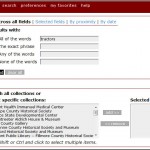 To find images of tractors in one or more of the collections, go to “Search” and type in the tractors. The search capability also provides the option to search in specific fields, so you can combine searches, such as title and description, or you can limit by date. If you wish, the search can also be limited by collection.
To find images of tractors in one or more of the collections, go to “Search” and type in the tractors. The search capability also provides the option to search in specific fields, so you can combine searches, such as title and description, or you can limit by date. If you wish, the search can also be limited by collection.
So pick your favorite topic, dig into Nebraska Memories, and harvest information for your personal or educational adventures into Nebraska history.
Nebraska Memories is a cooperative project to digitize Nebraska-related historical and cultural heritage materials and make them available to researchers of all ages via the Internet. Nebraska Memories is brought to you by the Nebraska Library Commission. If your institution is interested in participating in Nebraska Memories, see http://nlc.nebraska.gov/nebraskamemories/participation.aspx for more information, or contact Beth Goble, Government Information Services Director, or Devra Dragos, Technology & Access Services Director.
Posted in General, Nebraska Memories, Technology
Leave a comment
The Flood of 1881
The Missouri river has flooded many times in recorded history. Floods levels this year may exceed even the record flood of 1952. Although floodwaters were not that high in the flood of 1881, significant damage was done and lives were lost. These two photos show floodwaters inundating the lumber yard and Union Pacific rail yard in Omaha in April 1881.
According to this article on the Nebraska Department of Natural Resources web site:
“The release of water, which was yellow with clay and debris from cornfields, trees, and houses, later flooded Omaha up to 9th Street. Several hundred yards of rip-rap “gave away like cheesecloth” before the floodwaters as they inundated the Union Pacific coal and lumber yards. The River reportedly remained high for several weeks and, during the height of flooding, was reported to have been five miles wide.”
This article from the April 11th 1881 Omaha Daily Bee Slowly Subsiding: The Demon of the Big Muddy Appeased records eyewitness accounts the morning of April 9th:
“At one o’clock this morning the water was rising gradually in the river and pouring into the basins surrounding the lumber and coal yards in overwhelming streams. The main current of the river seemed to diverge somewhat off its course ‘of the day before and to bear away toward the east shore. This was indicated by the action of the ice, which had heretofore pressed with dangerous force against the smelting works and government rip rap. The proprietors of the various lumber yards , the Chicago , Foster Gray and Hoagland , were on hand all night with gangs of men , endeavoring to construct booms around their yards … At six o’clock in the morning , the gauge showed an additional rise of nine inches above the measurement taken at twelve o’clock, making the total height above low water mark nearly twenty-three feet. By this time all of the lumber yards were filling rapidly ; the car shops and engine house belonging to the U. P. works were entirely surrounded and the aspect of affairs were most discouraging. Then , for some unexplained reason , the rise seemed to cease and it was hoped that the flood bad reached its limit. This condition of affairs continued for three hours , and the most active efforts were made to protect the pro0perty of the U. P. company , the smelting works and the lumber yards. At nine o’clock a rush came , and the side tracks which had up to that time acted as barriers to the progress of the flood began to show signs of weakness , and in a few minutes huge parts of the embankments had given away and the water was pouring into the last and remaining basins west of the smelting work . “
Click here to see more images in Nebraska Memories of the flood of 1881 in Omaha.
For more information about this year’s flooding visit this page on NebraskAccess.
Visit Nebraska Memories to search for or browse through many more historical images digitized from photographs, negatives, postcards, maps, lantern slides, books and other materials.
Nebraska Memories is a cooperative project to digitize Nebraska-related historical and cultural heritage materials and make them available to researchers of all ages via the Internet. Nebraska Memories is brought to you by the Nebraska Library Commission. If your institution is interested in participating in Nebraska Memories, see http://nlc.nebraska.gov/nebraskamemories/participation.aspx for more information, or contact Beth Goble, Government Information Services Director, or Devra Dragos, Technology & Access Services Director.
Posted in General, Information Resources, Nebraska Memories, Technology
1 Comment
1911 Indianola Train Wreck
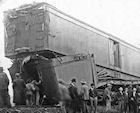 This past May 29th marked the 100th anniversary of a deadly train wreck that happened at about 7 am a half mile west of Indianola Nebraska. There are two photos in Nebraska Memories that show the severity of this crash. Looking at these pictures it’s hard to image how hard these trains had to collide for the engines to be destroyed and to push one train car on top of another.
This past May 29th marked the 100th anniversary of a deadly train wreck that happened at about 7 am a half mile west of Indianola Nebraska. There are two photos in Nebraska Memories that show the severity of this crash. Looking at these pictures it’s hard to image how hard these trains had to collide for the engines to be destroyed and to push one train car on top of another.
Over the years, as I’ve talked with people about Nebraska Memories, one comment I’ve heard multiple times is the desire to know more about the images in the collection. I completely agree unfortunately most of the time we don’t have any more then what is provided. When a photo is 100+ years old our knowledge is limited to the information that someone in the past has recorded. Maybe this desire to know more is the reason that I’m drawn to these two photos of the Indianola train wreck.
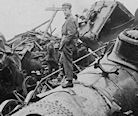 Surprisingly we know a lot about this particular crash thanks to The McCook Tribune and the Library of Congress’s Chronicling America Historic American Newspapers project. This project is an effort to digitize newspapers from all U.S. States and territories and make them available online. Luckily for us one of the papers included in this project is the May 30th 1911 edition of The McCook Tribune. On the front page of this issue is a story all about the “Appalling Accident” near Indianola.
Surprisingly we know a lot about this particular crash thanks to The McCook Tribune and the Library of Congress’s Chronicling America Historic American Newspapers project. This project is an effort to digitize newspapers from all U.S. States and territories and make them available online. Luckily for us one of the papers included in this project is the May 30th 1911 edition of The McCook Tribune. On the front page of this issue is a story all about the “Appalling Accident” near Indianola.
If you share the desire to know more, take the time to look at the images of the wreck in Nebraska Memories and read about this “Appalling Accident” that happened 100 years ago. You will learn a lot about the accident including the engine numbers of the trains involved, a list of people killed and even the names of people “not expected to recover”.
Visit Nebraska Memories to search for or browse through many more historical images digitized from photographs, negatives, postcards, maps, lantern slides, books and other materials.
Nebraska Memories is a cooperative project to digitize Nebraska-related historical and cultural heritage materials and make them available to researchers of all ages via the Internet. Nebraska Memories is brought to you by the Nebraska Library Commission. If your institution is interested in participating in Nebraska Memories, see http://nlc.nebraska.gov/nebraskamemories for more information, or contact Beth Goble, Government Information Services Director, or Devra Dragos, Technology & Access Services Director.
Posted in General, Information Resources, Nebraska Memories, Technology
2 Comments
Flying the Flag
 The U.S. flag has been displayed for many different reasons and occasions. In Nebraska Memories, some photographs and postcards show flags on regular display both outside and inside buildings. An example is this colorful postcard of the “Old People’s Home, Fontenelle Boulevard, Omaha, Nebr.” from the Omaha Public Library collection. On some of the larger images of the flag, try counting the stars—many of these flags would have had only 46. Here are more images.
The U.S. flag has been displayed for many different reasons and occasions. In Nebraska Memories, some photographs and postcards show flags on regular display both outside and inside buildings. An example is this colorful postcard of the “Old People’s Home, Fontenelle Boulevard, Omaha, Nebr.” from the Omaha Public Library collection. On some of the larger images of the flag, try counting the stars—many of these flags would have had only 46. Here are more images.
More photographs show the flag being used to decorate buildings, cars and floats for celebrations and special occasions. If one flag is good, more must be better, as in the “Decorated automobile” to the left, right? And, of course, you can always borrow the design, as the “Man and woman wearing flag print clothing” to the right have done. Both photographs are from the Nebraska State Historical Society collection. Also see these special occasion images.
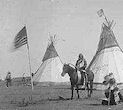
The flag is also used for ceremonial purposes or solemn occasions by the military and other groups. Several Nebraska State Historical images show the American flag at Native American gatherings including “Tipis of chiefs” from 1911. See more ceremonial images.
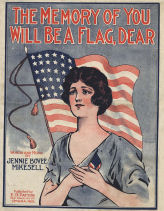
Before “The Star-Spangled Banner” became the U.S. national anthem in 1931, other patriotic songs were also written using our flag as a rallying point to protect “the republic for which it stands”. The musical score, “The Memory of You Will Be a Flag, Dear” from the Polley Music Library collection, is one of several available in Nebraska Memories.
Visit Nebraska Memories to search for or browse through many more historical images digitized from photographs, negatives, postcards, maps, lantern slides, books and other materials.
Nebraska Memories is a cooperative project to digitize Nebraska-related historical and cultural heritage materials and make them available to researchers of all ages via the Internet. Nebraska Memories is brought to you by the Nebraska Library Commission. If your institution is interested in participating in Nebraska Memories, see http://www.nlc.state.ne.us/nebraskamemories/ for more information, or contact Beth Goble, Government Information Services Director, or Devra Dragos, Technology & Access Services Director.
Wedding Bells
To celebrate the beginning of June, a traditional month for weddings, take a look at some of the images of weddings in Nebraska Memories. The celebrations range from large family gatherings to small wartime ceremonies, and they show how wedding customs have changed over the years.
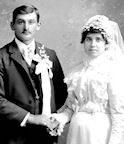
This 1902 portrait of Mr. and Mrs. Emmett Duffek is one of many wedding portraits taken by Harvey Boston, a photographer in David City. William Wentworth, an Omaha photographer, also took many wedding photographs in the 1940s, including this one at the Kelly wedding.

Visit Nebraska Memories to search for or browse through many more historical images digitized from photographs, negatives, postcards, maps, lantern slides, books and other materials.
Nebraska Memories is a cooperative project to digitize Nebraska-related historical and cultural heritage materials and make them available to researchers of all ages via the Internet. Nebraska Memories is brought to you by the Nebraska Library Commission. If your institution is interested in participating in Nebraska Memories, see http://www.nlc.state.ne.us/nebraskamemories/ for more information, or contact Beth Goble, Government Information Services Director, or Devra Dragos, Technology & Access Services Director.
Nebraska Marble
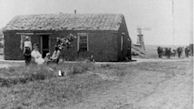
In 1862, the United States Congress passed the Homestead Act, which turned over large amounts of public land to private citizens. Homesteaders were able to claim 160 acres of land and were required to make improvements to the land, which included building a house on it within six months. On the Great Plains, where trees were scarce, many homesteaders built homes out of sod, which was jokingly called “Nebraska marble.” For more information on sod houses, explore these resources from the Smithsonian Institution or NebraskaStudies.org.
The house on the homestead of Herman Staberg is one example of a residence made of sod. Sod was not only used for houses, but for other buildings as well. This school in Cheyenne County and this church in Funk were both made out of sod. 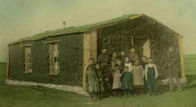
More images of sod buildings can be seen in Nebraska Memories.
Visit Nebraska Memories to search for or browse through many more historical images digitized from photographs, negatives, postcards, maps, lantern slides, books and other materials.
Nebraska Memories is a cooperative project to digitize Nebraska-related historical and cultural heritage materials and make them available to researchers of all ages via the Internet. Nebraska Memories is brought to you by the Nebraska Library Commission. If your institution is interested in participating in Nebraska Memories, see http://www.nlc.state.ne.us/nebraskamemories/ for more information, or contact Beth Goble, Government Information Services Director, or Devra Dragos, Technology & Access Services Director.
Posted in General, Information Resources, Nebraska Memories, Technology
1 Comment
Water Water Everywhere
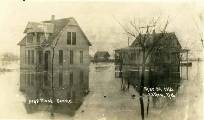
The flooding along the Missouri is worse than it’s been in many years. Water is being released from Lake McConaughy. There seems to be too much water everywhere. Nebraskans have experienced flooding in the past, of course, and some of them were photographed. This photograph of two houses in Valley shows flood waters from the Platte and Elkhorn Rivers that merged in March of 1912 and inundated the town. Flood waters up to four-feet deep left homes full of mud and silthttp://goo.gl/NDSmC
More photographs of the flood in Valley and other floods in Nebraska can be viewed by following this link
http://goo.gl/VZbrr
Visit Nebraska Memories to search for or browse through many more historical images digitized from photographs, negatives, postcards, maps, lantern slides, books and other materials.
Nebraska Memories is a cooperative project to digitize Nebraska-related historical and cultural heritage materials and make them available to researchers of all ages via the Internet. Nebraska Memories is brought to you by the Nebraska Library Commission. If your institution is interested in participating in Nebraska Memories, see http://www.nlc.state.ne.us/nebraskamemories/ for more information, or contact Beth Goble, Government Information Services Director, or Devra Dragos, Technology & Access Services Director.
Posted in General, Information Resources, Nebraska Memories
Leave a comment
Flower Garden Inspirations
Spring is here and many folks are busy working in their flower gardens. If you need a bit of inspiration for your garden maybe some photos from the early 1900’s can help.
One source of inspiration is Hanscom Park in Omaha. Hanscom Park was donated to Omaha in 1872 and is one of city’s oldest parks. The 58 acre park is still in existence today and is located in the area of 32nd and Woolworth Ave.  If you have a large yard maybe you want to consider adding a fountain and some flower beds. If that’s not your style how about creating you’re own rose bower or “Lovers lane” as one person noted on a postcard.
If you have a large yard maybe you want to consider adding a fountain and some flower beds. If that’s not your style how about creating you’re own rose bower or “Lovers lane” as one person noted on a postcard.
In addition to the images of the park there are also images of some smaller gardens. The Nye residence in Fremont had a formal garden complete with a gazing ball. The Christensen home, also in Fremont, had two circular flower plantings in the yard. There was even a flower garden in front of South Hall on the Union College campus. If you would rather keep your garden simple you could always take inspiration from J. F. Rosenfield Peony Gardens and just plant twenty-five acres of peonies.
If you are not into gardening and the heat of summer you can always wait for the snow to fly turning Hanscom Park into a winter beauty.
Visit Nebraska Memories to search for or browse through many more historical images digitized from photographs, negatives, postcards, maps, lantern slides, books and other materials.
Nebraska Memories is a cooperative project to digitize Nebraska-related historical and cultural heritage materials and make them available to researchers of all ages via the Internet. Nebraska Memories is brought to you by the Nebraska Library Commission. If your institution is interested in participating in Nebraska Memories, see http://www.nlc.state.ne.us/nebraskamemories/ for more information, or contact Beth Goble, Government Information Services Director, or Devra Dragos, Technology & Access Services Director.
Celebrating Mothers

The practice of honoring mothers has been around for centuries, but Mother’s Day was not an official holiday in the United States until President Woodrow Wilson signed legislation in 1914 establishing the date as the second Sunday in May.
Some people buy cards, flowers, or jewelry to honor their mothers. Others have said it with music, as in this piece, “Sweet Little Mother.” This score and other Mother-related musical materials can be found in the Polley Music Library collection.
 Cherished photographs bring back memories of mothers, grandmothers, great-grandmothers, and more, like this photograph of four generations in Clara Zellinger’s family from the Butler County Gallery collection. Nebraskans must be a hardy bunch as other photographs in Nebraska Memories show multiple generations. Formal and informal photographs of mothers with their children and family groups show a variety of family combinations. And check out the size of some of those families in past years. In comparison, the Census Bureau reports that the average number of births per woman in the United States had dropped to two in 2009.
Cherished photographs bring back memories of mothers, grandmothers, great-grandmothers, and more, like this photograph of four generations in Clara Zellinger’s family from the Butler County Gallery collection. Nebraskans must be a hardy bunch as other photographs in Nebraska Memories show multiple generations. Formal and informal photographs of mothers with their children and family groups show a variety of family combinations. And check out the size of some of those families in past years. In comparison, the Census Bureau reports that the average number of births per woman in the United States had dropped to two in 2009.
Visit Nebraska Memories to search for or browse through many more historical images digitized from photographs, negatives, postcards, maps, lantern slides, books and other materials.
Nebraska Memories is a cooperative project to digitize Nebraska-related historical and cultural heritage materials and make them available to researchers of all ages via the Internet. Nebraska Memories is brought to you by the Nebraska Library Commission. If your institution is interested in participating in Nebraska Memories, see http://www.nlc.state.ne.us/nebraskamemories/ for more information, or contact Beth Goble, Government Information Services Director, or Devra Dragos, Technology & Access Services Director.
Remembering Black Elk
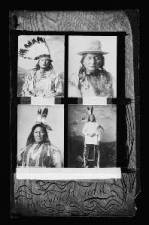
The 29th annual Neihardt Spring Conference will be held at the John G. Neihardt State Historical Site in Bancroft on April 30th, 2011. Many of us have read Black Elk Speaks, the story of the life of the Oglala holy man told to Neihardt in 1931. Black Elk lived through and participated in many of the events spanning the Battle of the Little Big Horn in 1876 to the massacre at Wounded Knee in 1990. He was a cousin to Crazy Horse and knew many Lakota leaders of those times.
This composite image Sitting Bull, Gall, White Bull, Rain in the Face is part of the Nebraska State Historical Society Collection in Nebraska Memories. Photographer John Alvin Anderson was commissioned as a civilian photographer for the U.S. Army to record life on the Rosebud Reservation in South Dakota north of Valentine.
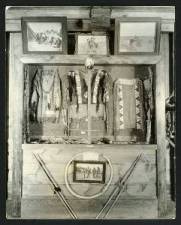 Shirts worn in the battle at Wounded Knee Nebraska State Historical Society Collection, 1890s. This photograph shows three animal hide shirts on display at the Sioux Indian Museum in Rapid City.
Shirts worn in the battle at Wounded Knee Nebraska State Historical Society Collection, 1890s. This photograph shows three animal hide shirts on display at the Sioux Indian Museum in Rapid City.
More photographs of Native Americans can be viewed in Nebraska Memories.
Visit Nebraska Memories to search for or browse through many more historical images digitized from photographs, negatives, postcards, maps, lantern slides, books and other materials.
Nebraska Memories is a cooperative project to digitize Nebraska-related historical and cultural heritage materials and make them available to researchers of all ages via the Internet. Nebraska Memories is brought to you by the Nebraska Library Commission. If your institution is interested in participating in Nebraska Memories, see http://www.nlc.state.ne.us/nebraskamemories/ for more information, or contact Beth Goble, Government Information Services Director, or Devra Dragos, Technology & Access Services Director.
Posted in General, Information Resources, Nebraska Memories
Leave a comment
Re-Shaping Omaha
When Omaha was founded, it looked very different from the city we know today. In the late 1800s and early 1900s, the streets of Omaha underwent a series of re-grading projects that drastically changed the city’s landscape. The level of the streets was lowered in some areas and raised in others. For example, in the late 1800s, at 17th and Farnam, the streets were lowered by 45 feet, and the dirt from this area was used to raise the grade between 20th and 24th Streets. Most buildings in the affected areas were moved to the new street level. Among the reasons for the re-grading, particularly in the later projects, was the need to make it easier for automobiles to navigate the steeply graded streets. In 1917, Dodge Street was re-graded from a 12% to a 7% grade so that cars would be able to more easily reach the top of the hill at 24th and Dodge Streets. (Source: National Register of Historic Places Registration Form for The Logan)
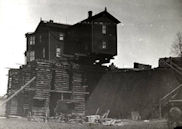
The Falconer residence, located at 1821 Douglas Street, was one of the buildings affected by street re-grading in the late 1800s. This series of photographs shows several images of the movement of the house, including a picture of it settled in its new position. Several other photographs of street re-grading work can be viewed in Nebraska Memories.
Visit Nebraska Memories to search for or browse through many more historical images digitized from photographs, negatives, postcards, maps, lantern slides, books and other materials.
Nebraska Memories is a cooperative project to digitize Nebraska-related historical and cultural heritage materials and make them available to researchers of all ages via the Internet. Nebraska Memories is brought to you by the Nebraska Library Commission. If your institution is interested in participating in Nebraska Memories, see http://www.nlc.state.ne.us/nebraskamemories/ for more information, or contact Beth Goble, Government Information Services Director, or Devra Dragos, Technology & Access Services Director.
Look at the Books on the Bookmobile
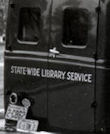
As we celebrate National Library Week and National Bookmobile Day on April 13th, it’s the perfect time to explore the history of Nebraska’s first bookmobile. The Nebraska Public Library Commission purchased their first bookmobile on July 28, 1936. I assumed that this bookmobile was purchased to deliver books to patrons around the state, however after doing a bit of research I realized I was wrong.
The Commission documented the purchase of the bookmobile in their 1935-1936 biennial report to the governor: “One of the most important aids in the program of the Library Commission has been the new Bookmobile purchased during the summer of 1936 and first displayed at the State Fair. The Library Commission is indebted to Mrs. R. L. Cochran for her interest in this project and to a group of Omaha business men for their gift of money which made the purchase of the book truck possible. The Bookmobile, which is a specially constructed half ton truck, is used for demonstration purposes and carries a carefully selected collection of three hundred books. It has done much to create interest in library extension.” *

It was reported in the September 4, 1936 issue of the State Journal that “The Nebraska bookmobile will be used for the present of demonstration. Following the state fair it will be on exhibit at some county fairs and will also be taken to several state conventions. . . . The books carried will be duplicates of books which may be borrowed from the library commission, chosen to show the type of service given by the commission. . . . It is hoped plans can be made to use the bookmobile for delivery of books within a limited territory.”

The bookmobile made many stops across the state as is documented by the photographs in Nebraska Memories. In the next year’s biennial report (1936-1938) it was documented that “Eighty-six of the ninety-three counties in the state have been visited by the Bookmobile.” ** In another report by the Commission it states “This “library on wheels” has traveled 4,000 miles over the state. . . and has been a big factor in making people in Nebraska aware of the service which is available to them through the Library Commission. It has resulted in an increased number of requests for books.”
There were a few other interesting things I noticed and wanted to share:
- Looking at the back of the bookmobile, there appears to be a AAA logo above the license plate. What type of emergency road service was needed and offered in the late 1930’s?
- Five of the bookmobile photos were taken in front of public libraries. What’s interesting is that the Commission has modern pictures of three of these libraries.
Visit Nebraska Memories to search for or browse through many more historical images digitized from photographs, negatives, postcards, maps, lantern slides, books and other materials.
Nebraska Memories is a cooperative project to digitize Nebraska-related historical and cultural heritage materials and make them available to researchers of all ages via the Internet. Nebraska Memories is brought to you by the Nebraska Library Commission. If your institution is interested in participating in Nebraska Memories, see http://nlc.nebraska.gov/nebraskamemories/ for more information, or contact Beth Goble, Government Information Services Director, or Devra Dragos, Technology & Access Services Director.
* State of Nebraska Report of the Nebraska Public Library Commission to the Governor, August 26, 1935 to November 30. 1936 – Page 11 (The full text of this document is available as part of Commission’s State Publications Clearinghouse Service.)
** Biennial Report of the Nebraska Public Library Commission, December 1, 1936, 10 November 30, 1938 – Page 11 (The full text of this report is also available online.)
Honoring Those Who Served
Nebraska was still a territory when the first shots of the U.S. Civil War (1861-1865) were fired 150 years ago at Fort Sumter, South Carolina, on April 12, 1861, and no battles were fought here. However, being a slavery-free region, a Nebraska volunteer regiment was raised and sent to fight with Union forces. Many veterans of that regiment returned after the war, while other veterans moved here to take advantage of the available land under the Homestead Act.
 The shared experiences of the war led many of the Union veterans to join the Grand Army of the Republic, a fraternal organization which eventually became a strong lobbying voice for the rights of veterans. Members, like the gentlemen in the picture to the right, belonged to regional “Departments” and often attended the annual National Encampments. Descendants of veterans formed their own organizations such as Sons of Union Veterans of the Civil War and Daughters of Union Veterans of the Civil War.
The shared experiences of the war led many of the Union veterans to join the Grand Army of the Republic, a fraternal organization which eventually became a strong lobbying voice for the rights of veterans. Members, like the gentlemen in the picture to the right, belonged to regional “Departments” and often attended the annual National Encampments. Descendants of veterans formed their own organizations such as Sons of Union Veterans of the Civil War and Daughters of Union Veterans of the Civil War.
 The first Sailors' and Soldiers' Homes in Nebraska, like this one outside of Grand Island in 1887, housed not only veterans of the Civil War but also their widows and mothers. And the first Decoration Day (later Memorial Day) was celebrated to honor Civil War veterans. Other Civil War materials such as cemetery monuments and records, musical scores, and portraits can be found in Nebraska Memories.
The first Sailors' and Soldiers' Homes in Nebraska, like this one outside of Grand Island in 1887, housed not only veterans of the Civil War but also their widows and mothers. And the first Decoration Day (later Memorial Day) was celebrated to honor Civil War veterans. Other Civil War materials such as cemetery monuments and records, musical scores, and portraits can be found in Nebraska Memories.
Visit Nebraska Memories to search for or browse through many more historical images digitized from photographs, negatives, postcards, maps, lantern slides, books and other materials.
Nebraska Memories is a cooperative project to digitize Nebraska-related historical and cultural heritage materials and make them available to researchers of all ages via the Internet. Nebraska Memories is brought to you by the Nebraska Library Commission. If your institution is interested in participating in Nebraska Memories, see nlc.nebraska.gov/nebraskamemories/ for more information, or contact Beth Goble, Government Information Services Director, or Devra Dragos, Technology & Access Services Director.
Posted in General, Information Resources, Nebraska Memories, Technology
1 Comment
A Bit of Humor
 With April 1st fast approaching it’s a good time to explore some of the humorous items that can be found in Nebraska Memories.
With April 1st fast approaching it’s a good time to explore some of the humorous items that can be found in Nebraska Memories.
Over the years I’m sure all of us have talked to a fisherman or a fisherwoman who’s had a tale of the one that got away. If they have been out fishing on Pibel Lake, located about 70 miles north of Grand Island, you might want to believe them. Looking at this postcard you can see that there are some big fish in Pibel Lake.
 Not into fishing, maybe Laurel and Hardy is more your style or how about a man dressed as a woman? In 1944 at the prisoners of war at Camp Atlanta, near Holdrege, Nebraska, a man dresses as a woman for the theatrical production of “Lovers“.
Not into fishing, maybe Laurel and Hardy is more your style or how about a man dressed as a woman? In 1944 at the prisoners of war at Camp Atlanta, near Holdrege, Nebraska, a man dresses as a woman for the theatrical production of “Lovers“.
![]() If your funny bone is still not tickled, maybe you’re not looking at things the right way. This group of folks state that “We are all right when you look at us the right way.”
If your funny bone is still not tickled, maybe you’re not looking at things the right way. This group of folks state that “We are all right when you look at us the right way.”
Before you plan any April Fool’s Day pranks, take a minute to read the lyrics of April First by Thurlow Lieurance and keep in mind “A chap who’s foolish but one day is doing well.”
Visit Nebraska Memories to search for or browse through many more historical images digitized from photographs, negatives, postcards, maps, lantern slides, books and other materials.
Nebraska Memories is a cooperative project to digitize Nebraska-related historical and cultural heritage materials and make them available to researchers of all ages via the Internet. Nebraska Memories is brought to you by the Nebraska Library Commission. If your institution is interested in participating in Nebraska Memories, see http://nlc.nebraska.gov/nebraskamemories/ for more information, or contact Beth Goble, Government Information Services Director, or Devra Dragos, Technology & Access Services Director.

